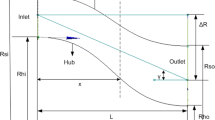Abstract
This study proposed a design and optimization strategy for a tandem arranged cascade using the Non-dominated Sorting Genetic Algorithm (NSGA) II multi-objective optimization algorithm and Back Propagation (BP) neural network technology. The NASA Stage 35 was employed as the initial bench mark in the present study and five geometric control parameters were working as the optimization parameters aiming to enhance the aerodynamic performance in terms of total pressure rise and efficiency. Results showed that the feasibility and capability of the proposed optimization strategy was successfully examined. In view of the fact that the initial tandem cascade (directly scaling down from NASA Stage 35) cannot guarantee the aerodynamic performance, first optimization trial was conducted to optimize the initial design. Results showed that the optimum can improve the flow quality whereas the separation on the blade is decayed or even eliminated particularly at the tip and root regions. However, compared with the initial tandem design, the enhancement in total pressure ratio (0.47%) and efficiency (1%) are too small to be noticed. Second investigation was particularly emphasizing on a high turning tandem compressor with an increment by 28°. The pressure rise and efficiency were augmented by 1.44% and 2.34% (compared to the initial tandem design), respectively. An important conclusion can be drawn that the optimization strategy is worthy to be used in high turning compressors with a considerable performance improvement.
Similar content being viewed by others
References
Hergt A., Meyer R., Engel K., Effects of vortex generator application on the performance of a compressor cascade. Journal of Turbomachinery, 2013, 135(2): 021026.
Schuler J., Kerrebrock L., Merchant A., Experimental inves tigation of an aspirated fan stage. In: Proc. of the ASME Turbo Expo 2002, Amsterdam, The Netherlands, 2002, Paper No. GT-2002-30370.
Flint W.L., Hilliday C.I., An experimental investigation of the aerodynamic characteristics of a cascade of circulation controlled aerofoils. Aeronautical Journal, 1982a: 68–75.
Fischer S., Saathoff H., Radespiel R., Numerical and ex perimental investigations on a low-speed compressor cascade with circulation control. In: Proc. of the ASME Turbo Expo 2008, Berlin, Germany, 2008, Paper No. GT2008-50302.
McGlumphy J., Ng W.F., Wellborn S.R. and Kempf S., 3D Numerical Investigation of Tandem Airfoils for a Core Compressure Rotor. Journal of Turbomachinery, 2010, 132: 031009.
Smith A.M.O., High-lift aerodynamics. Journal of Aircraft, 1975, 12(6): 501–530.
Roy B., Saha A., Experimental Analysis of Controlled Diffu sion Compressor Cascades with Single and Tandem Airfoils, New York, USA, 1995, ASME paper number 95-CTP-41.
Saha A. K., Roy B., Experimental Investigations on Tan dem Compressor Cascade Performance at Low Speeds, Experimental Thermal and Fluid Science, 1997, 14: 263–276.
Sheets, E., Multiple Row Blades for Blowers, Amsterdam, The Netherlands, 1988, ASME paper number 88-GT-124.
Bammert K., Staude R., Optimization for rotor blades of tandem design for axial flow compressors. Journal of Engineering for Power, 1980, 102(2): 369–375.
Sachmann J., Fottner L., Highly Loaded Tandem Com pressor Cascade with Variable Camber and Stagger, 1993, ASME paper number 93-GT-235.
Weber A., Steinert W., Design, Optimization, and Analysis of a High-Turning Transonic Tandem Compressor Cascade, 1997, ASME paper number 97-GT-412.
Falla G.C., Numerical investigation of the flow in tandem compressor cascades. Master Thesis, Vienna University of Technology, 2004.
Hoeger M., Baier R. D., Fischer S., Neudorfer J., High turning compressor tandem cascade for high subsonic flows, part 1: Aerodynamic design. AIAA, 2011, 2011–5601
Muller L., Kozulovic D., Wulff D., Fischer S. and Stark U., High Turning Compressor tandem cascade for high subsonic flows, Part 2: Numerical and Experimental Investigations. AIAA, 2011, 2011–5602.
Eshraghi H., Boroomand M., Tousi A.M., Fallah M.T., & Mohammadi A., The effect of variable stator on performance of a highly loaded tandem axial flow compressor stage. Journal of Thermal Science, 2016, 25(3): 223–230.
Mareinowski H., Messungen an axialen schaufelgittern, Das versuehswesen der Maseh-Fabr. J. M. Voith, Beitrag 24 Sonderheft, Hrsg. V. Fa. J. M. Voith, Heidenheim, 1949.
Sanger N.L., Analytical Study of the Effects of Geometric Changes on The Flow Characteristics of Tandem-Bladed Compressor Stators. NASA TN-D-6264, 1971.
Hasegawa H., Matsuoka A., Suga S., Development of highly loaded fan with tandem cascade. AIAA paper, 2003: 1065.
Liu X., Jin D., Gui X., Investigation of non-axisymmetric endwall contouring in a compressor cascade. Journal of Thermal Science, 2017, 26(6): 490–504.
Reid L., Moore R.D., Design and overall performance of four highly-loaded, high speed inlet stages for an advanced, high pressure ratio core compressor. NASA TP-1337, 1978.
Reid L., Moore R.D., Performance of a single-stage axi al-flow transonic compressor with rotor and stator aspect ratios of 1.19 and 1.26, respectively, and with design pressure ratio of 1.82. NASA TP-1338, 1978.
Zhang L., Liang Y., Jiang J., Yu R. and Fang K., Uniform design applied to nonlinear multivariate calibration by ANN. Analytics Chimica Acta, 1998, 370: 65–77.
Deng S., Percin M., van Oudheusden BW., Bijl H., Remes B and Xiao T. Numerical Simulation of a Flexible X-Wing Flapping-Wing Micro Air Vehicle. AIAA Journal, 2017, 55(7): 2295–2306.
Acknowledgement
This work has been supported by the National Natural Science Foundation of China (No. 51376150).
Author information
Authors and Affiliations
Corresponding author
Additional information
This study is financially supported by the National Natural Science Foundation of China (No. 51376150).
Rights and permissions
About this article
Cite this article
Yue, S., Wang, Y. & Wang, H. Design and Optimization of Tandem Arranged Cascade in a Transonic Compressor. J. Therm. Sci. 27, 349–358 (2018). https://doi.org/10.1007/s11630-018-1013-4
Received:
Published:
Issue Date:
DOI: https://doi.org/10.1007/s11630-018-1013-4



